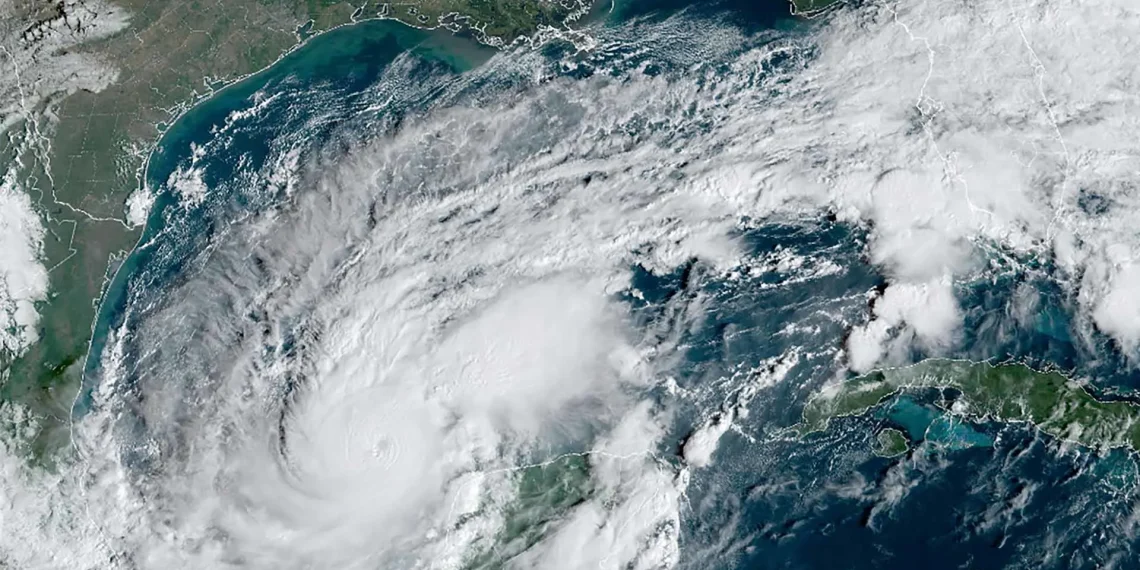When Will Hurricane Hit Florida? This question keeps millions of Florida residents awake at night during hurricane season.
The 2025 Atlantic hurricane season is already showing signs of above-average activity.
Florida faces potential tropical threats throughout the season, with meteorologists tracking multiple systems.
Your safety depends on staying informed about the latest forecasts and preparation timelines.

Current Hurricane Threats Targeting Florida
Active Systems Being Monitored
The National Hurricane Center is currently tracking areas of interest in the Gulf of Mexico near Florida.
If a tropical storm does form, it would be known as Tropical Storm Dexter according to the latest National Hurricane Center updates.
Current monitoring status:
- Low-pressure system developing in the Gulf of Mexico
- Potential tropical development possible within the next week
- Florida’s Gulf Coast and Panhandle under close observation
- Flooding concerns from Florida to Louisiana regardless of development
Immediate Timeline for Florida Impact
The most concentrated rainfall will push westward through the northern Gulf Coast through Thursday.
Here’s what Florida residents need to know right now:
This Week’s Threat Level:
- Monday-Wednesday: Increased shower and thunderstorm activity
- Thursday-Friday: Peak rainfall potential across northern Florida
- Weekend: System likely to move westward away from Florida
- Next Week: Continued monitoring of additional tropical waves
The current system poses primarily a flooding threat rather than wind damage.
Even without tropical storm development, heavy rainfall can cause significant flooding across Florida.
2025 Atlantic Hurricane Season Forecast
Expert Predictions for Florida
NOAA’s outlook for the 2025 Atlantic hurricane season predicts a 60% chance of an above-normal season.
Key Forecast Numbers:
- 13-19 total named storms predicted
- 6-10 hurricanes expected
- 3-5 major hurricanes (Category 3+)
- Season runs June 1 – November 30, 2025
Dr. Phil Klotzbach and his team are now predicting 16 total named storms through the end of the year.
Colorado State University Updated Forecast
The latest research shows a slight reduction in activity compared to earlier predictions.
CSU Forecast Details:
- 16 named storms (down from 17)
- 8 hurricanes expected
- 4 major hurricanes anticipated
- Above-average season still predicted
The team predicts that 2025 hurricane activity will be about 125% of the average season from 1991-2020.
Peak Hurricane Season Timeline for Florida
When Florida Faces Greatest Risk
Hurricane season doesn’t affect Florida equally throughout its duration.
Peak Threat Periods:
- Late June – Early July: Early season development possible
- August: Peak month for intense hurricane activity
- September: Historically most active month for Florida impacts
- October: Late season threats still possible
Those are dates that the weather pattern should yield a threat toward us, whether or not it becomes tropical or just a storm system.
Monthly Breakdown of Hurricane Risk
June Activity:
- Season officially begins June 1st
- Early season storms typically weaker
- Gulf of Mexico storms more common
- Rainfall flooding primary concern
July Threats:
- Tropical wave activity increases
- Cape Verde season begins
- Temperature patterns favor development
- Florida’s east coast monitoring increases
August Dangers:
- Peak Atlantic hurricane activity
- Strongest storms typically form
- Multiple systems often active simultaneously
- Highest probability of major hurricane formation
September Peak:
- Historically most active month
- Greatest threat to Florida’s coastline
- Multiple landfalls possible
- Strongest storms reach peak intensity
Florida’s Vulnerability by Region
Gulf Coast Hurricane Risk
Florida’s Gulf Coast faces unique hurricane challenges.
West Coast Threat Factors:
- Warm Gulf of Mexico waters fuel rapid intensification
- Shorter forecast lead times
- Storm surge amplification in shallow waters
- Multiple barrier islands increase vulnerability
Tampa Bay Area:
- Extremely vulnerable to storm surge
- Dense population complicates evacuation
- Historical hurricane gaps create false security
- Rapid intensification scenarios pose greatest threat
Atlantic Coast Hurricane Exposure
Florida’s Atlantic coastline experiences different hurricane patterns.
East Coast Considerations:
- Longer tracking time for approaching storms
- Cape Verde hurricanes follow predictable paths
- Stronger building codes in newer construction
- Beach erosion increases vulnerability annually
South Florida Specifics:
- Hurricane Alley location
- Dense urban population
- Extensive canal systems
- Historical major hurricane impacts
Current Ocean Conditions Affecting Florida
Sea Surface Temperatures
In 2025, the Tropical Atlantic is generally warmer than average, though much less so than the extremes of 2023 or 2024.
Temperature Impact on Hurricanes:
- Warmer water provides more energy
- Rapid intensification becomes more likely
- Storms maintain strength longer
- Increased precipitation potential
Wind Shear Patterns
Wind shear significantly affects hurricane development and intensity.
Current Shear Conditions:
- Moderate wind shear expected
- Periodic favorable development windows
- Steering pattern changes anticipated
- Gulf of Mexico particularly vulnerable

Hurricane Preparation Timeline for Florida
72-Hour Preparation Window
When a hurricane threatens Florida, preparation becomes critical.
72 Hours Before Impact:
- Finalize evacuation plans
- Secure outdoor furniture and decorations
- Stock up on essential supplies
- Fill vehicle gas tanks
48 Hours Before Impact:
- Install hurricane shutters
- Charge all electronic devices
- Withdraw cash from ATMs
- Confirm shelter locations
24 Hours Before Impact:
- Complete all outdoor preparations
- Move to safe shelter location
- Avoid travel unless evacuating
- Monitor weather updates continuously
Essential Supply Checklist
Water and Food:
- 1 gallon of water per person per day (7-day supply)
- Non-perishable food for 7 days
- Manual can opener
- Coolers and ice
Medical Supplies:
- Prescription medications (30-day supply)
- First aid kit
- Medical devices and batteries
- Emergency contact information
Communication and Light:
- Battery-powered radio
- Flashlights and extra batteries
- Cell phone chargers
- Emergency contact list
Florida Hurricane History and Statistics
Recent Major Impacts
Florida has experienced significant hurricane impacts in recent years.
2024 Hurricane Season:
- Hurricane Helene caused massive storm surge
- Hurricane Milton brought widespread damage
- Multiple tropical storm impacts
- Billions in property damage
Historical Context:
- Florida receives more hurricane strikes than any other state
- Average of 1-2 direct impacts per year
- Major hurricanes (Category 3+) strike every 3-4 years
- Storm surge causes 90% of hurricane fatalities
Economic Impact Statistics
Annual Hurricane Costs:
- Average seasonal damage: $5-15 billion
- Insurance claims exceed $10 billion annually
- Economic disruption affects entire state
- Recovery periods last 6-18 months
Property Risk Factors:
- 6.8 million Florida homes at risk
- $1.6 trillion in property value exposed
- Coastal properties face highest risk
- Flood insurance participation remains low
Advanced Hurricane Tracking Technology
Modern Forecasting Capabilities
Hurricane prediction has improved dramatically in recent decades.
Current Forecast Accuracy:
- 5-day track forecasts 70% accurate
- 3-day intensity forecasts 80% accurate
- Storm surge predictions increasingly reliable
- Rainfall forecasts continuously improving
Tracking Tools Available:
- Satellite imagery updates every 15 minutes
- Hurricane hunter aircraft provide real-time data
- Doppler radar monitors storm structure
- Computer models run multiple scenarios
Social Media and Alert Systems
Emergency Alert Systems:
- Wireless Emergency Alerts (WEA)
- Emergency Alert System (EAS)
- Local television and radio updates
- Social media monitoring
Official Information Sources:
- National Hurricane Center (nhc.noaa.gov)
- Florida Division of Emergency Management
- Local emergency management offices
- Weather.gov local forecasts
Climate Change Impact on Florida Hurricanes
Changing Storm Patterns
Climate change affects hurricane behavior in multiple ways.
Observed Changes:
- Increased rapid intensification events
- Slower-moving storms cause more flooding
- Storm surge heights increasing
- Precipitation amounts growing
Future Projections:
- Stronger peak intensities expected
- Sea level rise amplifies storm surge
- Extended season duration possible
- More frequent extreme rainfall events
Adaptation Strategies
Building Code Improvements:
- Stronger wind resistance requirements
- Elevated foundation standards
- Impact-resistant window mandates
- Improved drainage systems
Infrastructure Upgrades:
- Hardened electrical grid
- Improved water treatment facilities
- Enhanced communication systems
- Expanded evacuation routes
When to Evacuate Florida
Evacuation Zone Determination
Florida’s evacuation zones help residents understand their risk level.
Zone Classifications:
- Zone A: Greatest storm surge risk
- Zone B: Moderate storm surge risk
- Zone C: Minimal storm surge risk
- Zone D: Inland flooding risk
- Zone E: Minimal evacuation risk
Evacuation Timing Guidelines
Category 1 Hurricane:
- Zone A residents should evacuate
- Mobile home occupants evacuate
- Flood-prone areas evacuate
- 24-48 hours before landfall
Category 2 Hurricane:
- Zones A and B evacuate
- Coastal communities evacuate
- Barrier islands evacuate
- 48-72 hours before landfall
Category 3+ Hurricane:
- Multiple zones evacuate
- Massive evacuation effort required
- Interstate highways may close
- 72+ hours before landfall
Post-Hurricane Recovery Planning
Immediate Post-Storm Actions
Safety First:
- Avoid standing water
- Check for gas leaks
- Inspect structural damage
- Document damage with photos
Insurance Claims:
- Contact insurance companies immediately
- Keep all receipts for temporary repairs
- Avoid permanent repairs until adjuster visits
- Understand policy coverage limits
Long-Term Recovery Considerations
Rebuilding Decisions:
- Consider flood-resistant materials
- Upgrade to current building codes
- Evaluate relocation options
- Plan for future hurricane threats
Community Recovery:
- Participate in local recovery efforts
- Support affected neighbors
- Advocate for infrastructure improvements
- Prepare for next hurricane season
Latest Hurricane Technology and Apps
Essential Hurricane Apps
Official Government Apps:
- FEMA app for emergency alerts
- Hurricane by American Red Cross
- Florida 511 for traffic conditions
- Ready.gov emergency information
Weather Tracking Apps:
- Weather Underground
- AccuWeather Hurricane Tracker
- Weather Channel app
- Storm Radar by Weather Underground
Home Monitoring Technology
Smart Home Hurricane Prep:
- Smart thermostats for energy conservation
- Security cameras for property monitoring
- Water sensors for flood detection
- Smart generators for power backup
Communication Technology:
- Satellite communicators for emergencies
- Two-way radios for family coordination
- Solar-powered phone chargers
- Emergency broadcast radios
Florida Hurricane Myths vs. Facts
Common Misconceptions
Myth: Opening windows reduces structural damage Fact: Opening windows increases internal pressure and causes more damage
Myth: Hurricanes don’t hit the same place twice Fact: Some areas experience multiple strikes within years
Myth: Concrete buildings are hurricane-proof Fact: All buildings face hurricane risks without proper preparation
Myth: Hurricane season predictions are always accurate Fact: Seasonal forecasts provide general guidance, not specific threats
Evidence-Based Hurricane Facts
Storm Surge Reality:
- 90% of hurricane deaths result from water, not wind
- Storm surge can penetrate 20+ miles inland
- Surge heights can exceed 20 feet in extreme cases
- Evacuation remains the only reliable protection
Wind Damage Truth:
- Category 1 hurricanes cause significant damage
- Mobile homes face destruction in any hurricane
- Debris becomes deadly projectiles
- Structural failure occurs progressively

Economic Preparedness for Hurricane Season
Financial Hurricane Planning
Insurance Coverage Review:
- Flood insurance requires 30-day waiting period
- Homeowners insurance excludes flood damage
- Windstorm coverage may have separate deductibles
- Business interruption insurance protects income
Emergency Fund Recommendations:
- 3-6 months of expenses saved
- Cash reserves for immediate needs
- Important documents in waterproof storage
- Digital copies stored in cloud storage
Property Protection Investments
Cost-Effective Upgrades:
- Hurricane shutters: $2,000-8,000
- Impact-resistant windows: $400-800 per window
- Roof reinforcement: $5,000-15,000
- Whole-house generators: $10,000-20,000
Return on Investment:
- Insurance premium reductions
- Reduced property damage
- Faster post-storm recovery
- Increased property values
Community Hurricane Preparedness
Neighborhood Coordination
Community Preparation Benefits:
- Shared resource planning
- Elderly and disabled assistance
- Information sharing networks
- Coordinated evacuation efforts
Local Emergency Management:
- County emergency management offices
- Municipal emergency coordinators
- School district emergency plans
- Healthcare facility preparations
Volunteer Opportunities
Hurricane Response Volunteering:
- American Red Cross disaster relief
- Salvation Army emergency services
- Local faith-based organizations
- Community emergency response teams
Pre-Season Preparation:
- Emergency shelter setup training
- Communication system testing
- Supply distribution planning
- Evacuation route improvement
FAQs
When can Florida expect a hurricane?
Florida’s hurricane season runs from June 1 to November 30. Peak activity usually occurs between August and October.
Is there a hurricane in Florida right now?
Check the National Hurricane Center for real-time updates. Conditions change rapidly during hurricane season.
What part of Florida is most likely to be hit by a hurricane?
Southeast Florida and the Florida Keys are among the most hurricane-prone areas. Miami-Dade, Monroe, and Broward counties face frequent threats.
When have hurricanes hit Florida?
Florida has been hit by over 120 hurricanes since 1851. Major recent events include Irma (2017), Michael (2018), and Ian (2022).
Where in Florida is safest from hurricanes?
North-central Florida cities like Gainesville and Ocala are less frequently hit. Inland locations generally face lower risks.
What is a category 3 hurricane?
A Category 3 hurricane has wind speeds of 111–129 mph. It causes devastating damage to homes, trees, and infrastructure.
Conclusion: Staying Safe During Florida Hurricane Season
When will hurricane hit Florida?
The answer changes constantly throughout hurricane season.
The season officially began on June 1, 2025, and will end on November 30, 2025.
Current forecasts predict an above-average season with 16 named storms expected.
Florida residents must maintain vigilance throughout the entire season.
Key Takeaways:
- Monitor weather forecasts daily during hurricane season
- Prepare emergency supplies before storms threaten
- Know your evacuation zone and routes
- Stay informed through official sources
- Don’t wait for mandatory evacuations to make decisions
Remember: Hurricane forecasting continues improving, but preparation remains your best protection.
The 2025 hurricane season presents significant challenges for Florida.
Stay informed, stay prepared, and prioritize safety over property.
Your life depends on taking hurricane threats seriously and acting quickly when warnings are issued.
Contact local emergency management offices for specific preparation guidance in your area.
Hurricane season lasts six months, but preparation should happen year-round.









